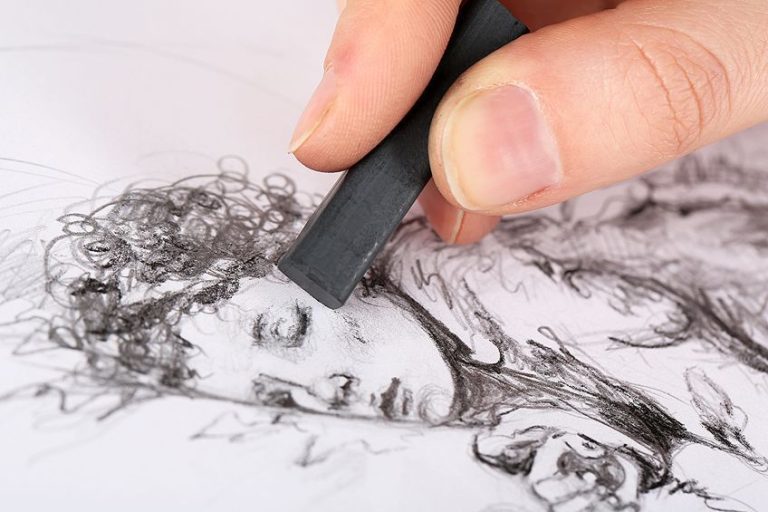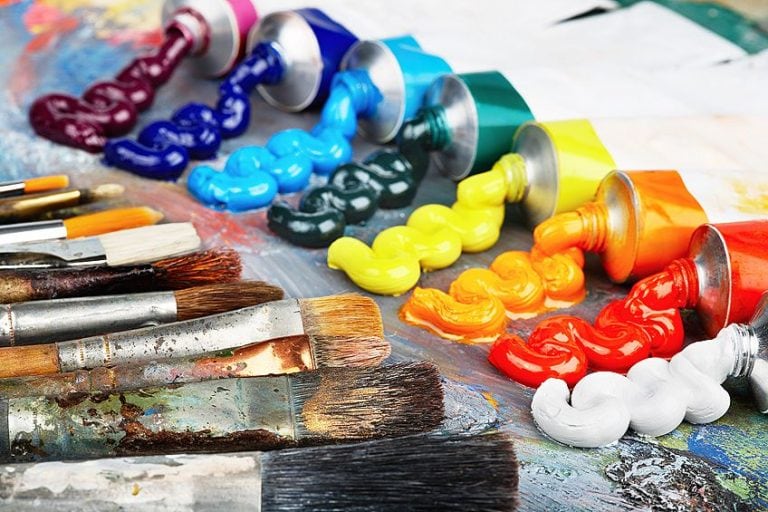What Is Painting? – Exploring the Mediums of Painting
This post may contain affiliate links. We may earn a small commission from purchases made through them, at no additional cost to you.
What is painting and what is a painting? In visual art, painting is the act of applying pigment to a surface, and a painting is a final artwork that results from this action. Throughout time, painting has played an important role in documenting the world around us, historical events, and our emotional states. Let’s learn about the art of painting’s history and significance, as well as explore types of paints and techniques that you can use when creating a painting of your own.
Table of Contents
What Is Painting?
In visual art, painting is a medium by which artists express certain emotions or concepts in a two-dimensional form using an array of aesthetic and technical principles. Artists use the basic elements of visual language, such as lines, colors, and shapes to produce the perception of movement, space, and light on a two-dimensional surface. These elements can be utilized to produce anything from naturalistic and life-like portrayals to highly abstract art scapes.
Painting is regarded as important because it has played many roles in the development of civilization and culture.

It has been used as a tool for imparting both religious and political ideas, as well as expressing the thoughts and feelings of individuals. Therefore, painting has also acted as a form of visual documentation of human history, enabling us to observe how events of the past were perceived by the people of the time. Even before there was written language, we humans used painting as a way of disseminating our ideas and information.
The History of Painting
Humans have been painting for a considerably long time, around 40,000 years to be precise. While these early humans did not have any of the painting tools that we have today, they were still able to produce astonishingly life-like depictions of animals and flora using natural pigments that lasted through the centuries up to the present day.
The subject matter of much early cave art revolved around the animals that they hunted, and over time included various religious and ceremonial motifs as well.
The Development of Painting
Early in our collective history cultural traditions dominated the style, form, iconography, and subject matter of paintings and dictated their function, whether ceremonial, religious, ornamental, educational, or meant for entertainment. Painters were hired as skilled artisans rather than creative artists. Later on, in Renaissance-era Europe and Asia, the concept of the “fine artist” emerged. Renowned painters were accorded the social rank of professors and courtiers; they began signing their works, chose their design and, in many cases, theme and iconography, and had a more personal relationship with their patrons.
During the 19th century, artists in Western nations started to lose social standing and sponsorship.
Some artists responded to the reduction in patronage support by organizing their own exhibits and charging admission. Others made money by touring various cities and exhibiting their works. Artists began to try to appeal to a specific art market, which replaced them having to meet the demands of patrons, and its impact on the art itself was considerable. 20th-century artists could mostly only access an audience through public institutions and commercial galleries, but their work was occasionally reprinted in art publications.

They had earned the flexibility, though, to create their own visual language and explore new forms, techniques, and materials. The persistent desire to push the boundaries of expression resulted in constant worldwide stylistic shifts. The succession of new and innovative art movements in painting was propelled by the rapid exchange of ideas through international art publications, touring exhibits, and art centers.
Such exchanges intensified in our current era with the proliferation of global art fairs and the emergence of social media, which provided not only novel means of self-expression but also a direct connection between the artists and their fans.
The Role of the Painter over Time
The painter’s function has evolved over time in response to the cultural and socioeconomic setting in which they lived. Painters have typically been acknowledged throughout history as those who have a special aptitude for producing and expressing their thoughts and feelings through visual means, or the ability to capture a specific moment, place, or person. Painters were frequently seen as crafters in the ancient world, creating paintings for ceremonial or religious purposes. Liang Kai, a Chinese painter noted for his Buddhist paintings, is a notable and influential painter from the ancient world.
Throughout the medieval era, painters were mostly commissioned to make religious artworks by the church or rich clients.
The Italian artist, Giotto de Bondone, a painter best known for his paintings in Padua’s Scrovegni Chapel, is one of the most renowned medieval artists. The Renaissance era witnessed a massive shift in the painter’s status, who was now regarded as a creative genius with unique abilities and talents. Renaissance painters like Leonardo da Vinci and Michelangelo created works that mirrored the Renaissance’s ideals and beliefs.

The dramatic, theatrical paintings of the Baroque era were defined by painters like Rembrandt and Caravaggio, who produced paintings that expressed the emotional and spiritual intensity of the age. Artists have taken on a broad range of roles throughout the modern and contemporary age, including opposing societal standards, expressing political and personal opinions, and pushing art in a multitude of fascinating directions.
Frida Kahlo, Pablo Picasso, Andy Warhol, and Banksy are examples of modern and contemporary painters that helped shape the art landscape during and after their prolific careers.
Painting Techniques
Now that we have learned what role painters and painting played in the history of art, we can learn how to create our own paintings. As someone just starting out with painting, you are free to experiment with whichever style and subject matter you wish! It’s also important to experiment with the various types of paint available, especially when first beginning to paint, as each type of paint is used in a distinct way, with varying drying times and finishes.
Types of Paint Used by Artists
Artists have a variety of paint types to choose from, and each one offers its own unique characteristics. Some dry slower than others, allowing artists to rework sections before they dry, and some types of paint are more transparent, allowing for more delicate washes and looks. Knowing the various types of paint will assist you in choosing the correct medium for your specific project. If, for example, you don’t like to wait for the paint to dry, then you would probably be better off using acrylic paint rather than oil paint. Here are a few of the more commonly used types of paint.
Oil Paint
Oil paint is created using a binder of oil made from either poppy seed, linseed, or walnut, which provides an artwork with a glossy sheen and offers artists a slower drying period. It is quite resilient and can be easily layered and mixed. It is typically applied to canvas, wood, and metal surfaces. Oil paint is well-known for producing rich, vivid colors as well as its ability to produce subtle tone changes.

Acrylic Paint
Acrylic paint is a water-based type of paint that dries fast and is very fade-resistant. Acrylic paint is often used for abstract painting because it can be quickly layered. It is also quite adaptable, since it may be diluted with water or mixed with other mediums to achieve a variety of effects.
Watercolor Paint
Watercolor paint is a popular water-soluble type of paint with a gum Arabic binder. It dries fast and easily, although it is not as durable as the above-mentioned types of paint. It is also lightweight and portable, making it ideal for Plein air landscape painting.

Gouache Paint
Gouache paint is comparable to watercolor, except it contains more pigment and has a considerably more opaque finish. It is widely used in graphic design and illustration and may be applied to a range of media, including paper and board. It is also quite adaptable, allowing you to achieve a wide range of effects, from light washes to thick impasto.
Painting Tools and Materials
As we have discovered, in visual art, paintings can be made with a variety of pigments on a multitude of surfaces. But, if you want to paint properly and professionally, you might want to consider investing in more than just paint, brushes, and canvases. Here are a few essential painting tools and materials that can normally be found in an artist’s bag.
Paintbrushes
While this might seem like stating the obvious, paintbrushes are one of the most essential tools in your possession, so it’s important that you invest in brushes that won’t become messy and lose hair every time you try to paint. It’s also important to have a decent variety of different brushes, as each one can be used to perform very specific tasks in your painting based on its size and shape.
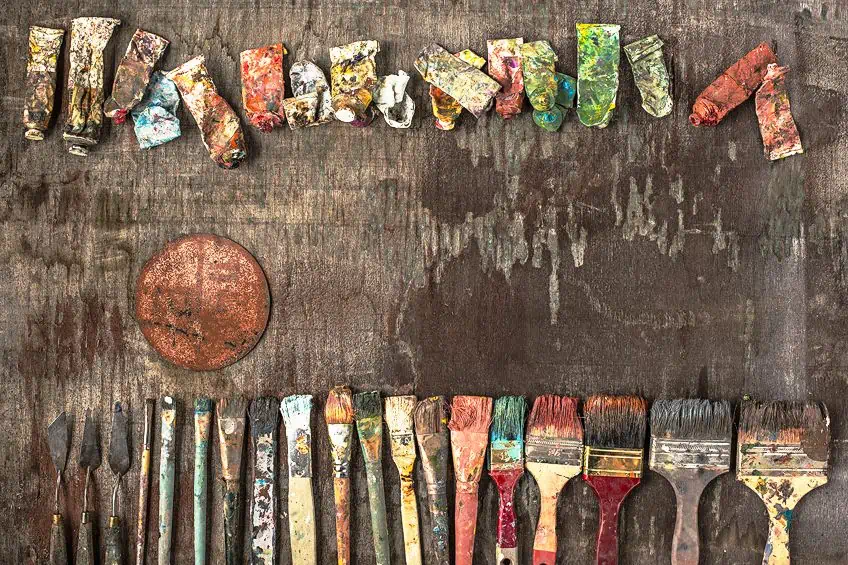
Palette
Most of the time, you won’t be using the color straight out of the tube but will most likely prefer to mix and blend it with other colors. Color palettes are perfect for this job, and there are plenty of different sizes and types to choose from. You can find wood, plastic, and even glass palettes in stores, although many painters will just as easily use a piece of cardboard or Tupperware lid as their palette.
Easel
While many painters settle with painting on a desk or table, most professional artists prefer working at an easel. This is because they are able to secure the work to the easel, which prevents it from moving, or anything spilling on it. Easels are also better for the artist’s posture and reduce strain on the back and neck, as they are not bent down for hours.
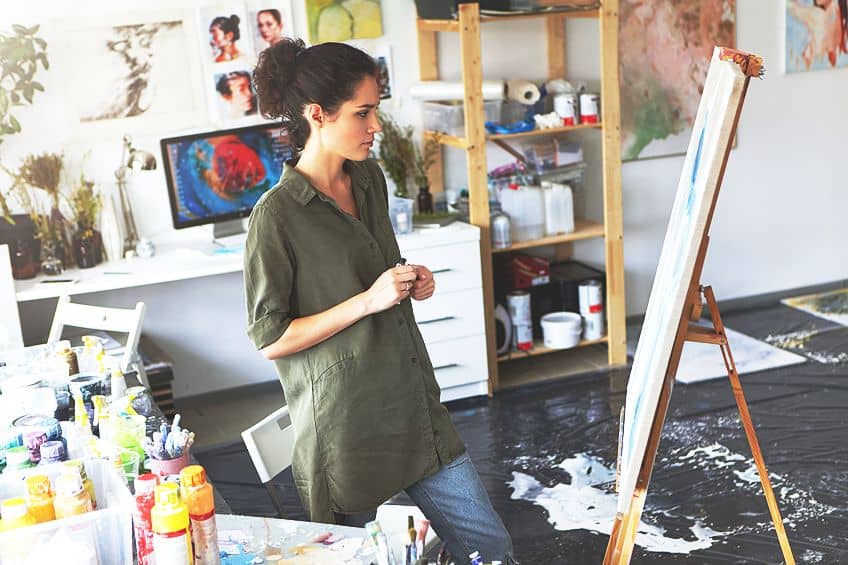
Solvents and Mediums
It also helps to have various solvents and mediums at hand, in case you would like to thin out your paint or make it dry quicker. Solvents such as mineral spirits are great for cleaning brushes as well as thinning out colors. Mediums are great if you wish to modify the drying time or produce a certain finish.
Techniques
When you first start painting, the first technique you want to explore is color mixing. By learning how various colors mix to produce other colors, you can greatly increase the number of colors available to you with only a few tubes of paint. Another technique you can play around with is the dry brush technique.
You can use a dry brush to create all sorts of interesting textures on your canvas.
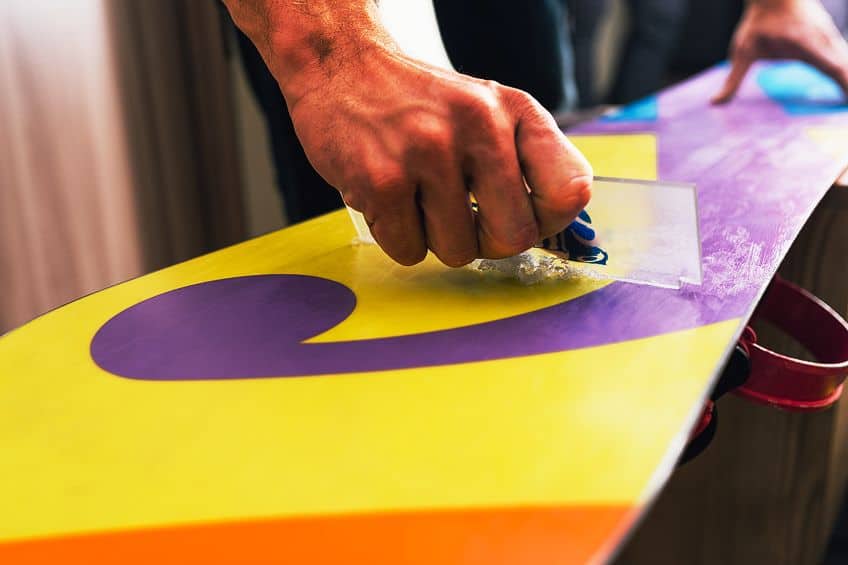
A great technique for adding texture to a painting is sgraffito. In this technique, you add many layers of paint on top of each other and then scratch away at the surface to reveal the colors underneath. Another technique to experiment with is called stippling. In this technique, you use your brush to apply small dots of paint over the surface.
That about covers it for this introduction to the world of painting. As we have discovered, there are many types of paint and surfaces that you can explore if you wish to start painting. Pick a type of paint that best suits your project and have fun! Don’t forget to try out a few techniques that we have suggested!
Frequently Asked Questions
What Is Painting?
Painting involves applying pigments to a surface, typically with a brush. This ranges from painting your house to painting a masterpiece. As a medium of visual art, painting has also documented the various eras and individuals in our history. Painting also serves as a great form of expression.
What Is a Painting?
While painting can even refer to changing the color of your roof, a painting is usually a work of art. A painting is typically produced on a canvas, or even a wall, using either tempera, oil, acrylic, watercolor, or another type of paint. Paintings can be produced for a patron or for oneself. If one hopes to make money from painting, then there is usually the requirement of painting a specific topic chosen by the buyer. However, if you are just painting for pleasure, there is no limit to the subject matter!
In 2005, Charlene completed her wellness degrees in therapeutic aromatherapy and reflexology at the International School of Reflexology and Meridian Therapy. She worked for a company offering corporate wellness programs for several years before opening her own therapy practice. In 2015, she was asked by a digital marketer friend to join her company as a content creator, and it was here that she discovered her enthusiasm for writing. Since entering the world of content creation, she has gained a lot of experience over the years writing about various topics such as beauty, health, wellness, travel, crafting, and much more. Due to various circumstances, she had to give up her therapy practice and now works as a freelance writer. Since she is a very creative person and as a balance to writing likes to be active in various areas of art and crafts, the activity at acrylgiessen.com is perfect for her to contribute their knowledge and experience in various creative topics.
Learn more about Charlene Lewis and about us.





